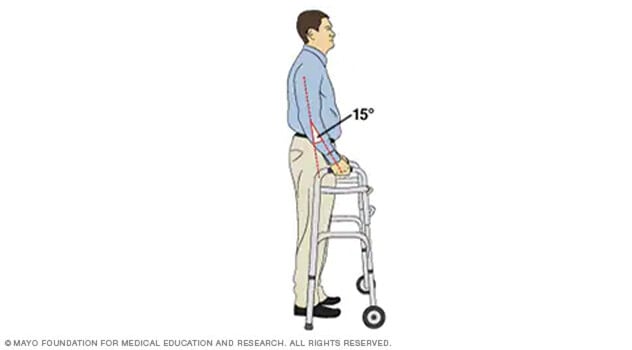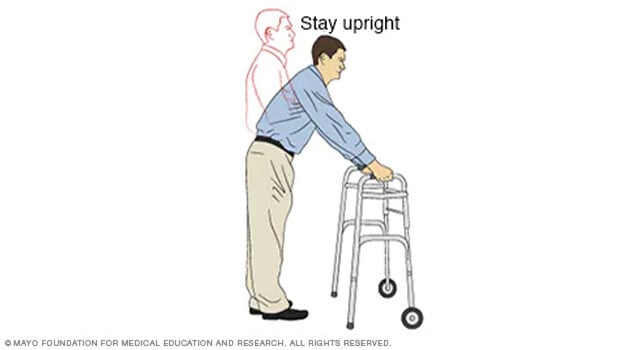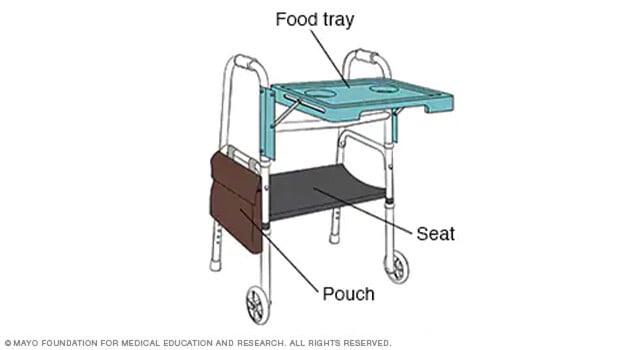Tips for choosing and using walkers
A walker can make it easier to get around after surgery or after a bone break in your foot or leg. A walker also can help if you have balance problems, arthritis, leg weakness or leg instability. A walker allows you to keep weight off your feet and legs as you move.
Types of walkers

Talk to your doctor, physical therapist or another member of your health care team about the type of walker that's right for you. Options include:
- Standard walker. A standard walker is sometimes called a pickup walker. It has four rubber-tipped legs. It does not have wheels. This type of walker provides the most stability. You have to lift this walker to move it.
- Two-wheel walker. This walker has wheels on the two front legs. It's useful if you need some help bearing weight as you move, or if lifting a standard walker is hard for you. It can be easier to stand fully upright with a two-wheel walker than it is with a standard walker. That may help improve posture and lower the risk of falls.
- Four-wheel walker. This walker offers continuous balance support. Using a four-wheel walker can be helpful if you are unsteady on your feet. But it tends to be less stable than a standard walker. If endurance is a concern, this type of walker often has the option for a seat.
- Three-wheel walker. This walker provides continuous balance support. But it is lighter and easier to move than a four-wheel walker, especially in tight spaces.
- Knee walker. This walker has a knee platform, four wheels and a handle. To move, you rest the knee of your injured leg on the platform and push the walker with your other leg. A knee walker typically is used for a short time when an ankle or foot problem makes walking difficult.
Selecting a grip

Most walkers come with plastic grips, but there are other choices too. You might consider foam grips or soft grip covers, especially if your hands tend to get sweaty. If you have trouble grasping with your fingers, you might like a larger grip. Choosing the correct grip eases stress on your joints. Whichever grip you choose, be sure the grip is secure so that it won't slip while you're using the walker.
Fitting your walker

Adjust your walker so that it fits your arms comfortably. This eases stress on your shoulders and back. To tell if your walker is the right height, step inside your walker and:
- Check your elbow bend. Keeping your shoulders relaxed, place your hands on the grips. Your elbows should bend at a comfortable angle of about 15 degrees.
- Check your wrist height. Stand inside the walker and relax your arms at your sides. The top of the walker grip should line up with the crease on the inside of your wrist.
Moving forward

If you need to place weight on the walker as you move, start by putting the walker about one step ahead of you. Keep your back upright. Don't hunch over the walker.
Stepping into the walker

Next, if one of your legs is injured or weaker than the other, put that leg into the middle area of the walker first. Keep your foot behind the front legs of the walker. If you step too far forward, you could lose your balance. Keep the walker still as you step in.
Stepping with the other foot

Finally, push straight down on the grips of the walker to support your weight as you bring your other leg forward. Repeat the process by moving your walker forward and stepping into it one leg at a time.
Move carefully

Follow these safety tips when you use a walker:
- Stay upright as you move. This helps protect your back from strain or injury.
- Step into the walker, rather than walking behind it.
- Don't push the walker too far out in front of you.
- Make sure the handles are set at the right height.
- Take small steps and move slowly when you turn.
- Be careful when using a walker on surfaces that are slippery, carpeted or uneven.
- Watch for objects on the ground.
- Wear low-heeled shoes that have good grips on the soles.
Walker accessories

Options and accessories can make your walker easier to use. For example:
- Some walkers fold up, making them more convenient to move and store.
- Some walkers with wheels have hand brakes.
- Trays can help you carry food, drinks and other items.
- A pouch attached to the side of a walker can carry books, a phone or other items you like to have with you.
- A walker with a seat can be helpful if you need to take breaks while walking.
- Baskets are useful if you use your walker when you go shopping.
Whatever walker you choose, don't overload it. And make sure to keep it in good working order. Worn-out or loose rubber caps or grips can raise the risk of falling. Brakes that are too loose or too tight also may raise the risk of falling. For help maintaining a walker, talk to your doctor, physical therapist or another member of your health care team.



